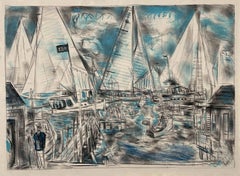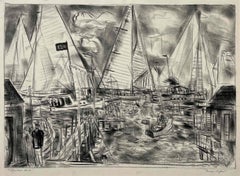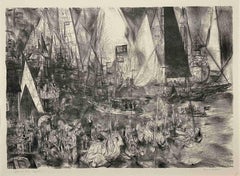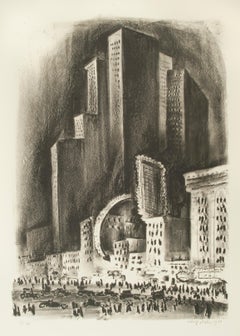Francis Chapin Prints and Multiples
American, 1899-1965
Francis Chapin, affectionately called the “Dean of Chicago Painters” by his colleagues, was one of the city’s most popular and celebrated painters in his day. Born at the dawn of the 20th Century in Bristolville, Ohio, Chapin graduated from Washington & Jefferson College near Pittsburgh, Pennsylvania before enrolling at the Art Institute of Chicago in 1922. He would set down deep roots at the Art Institute of Chicago, exhibiting there over 31 times between 1926 and 1951. In 1927 Chapin won the prestigious Bryan Lathrop Fellowship from the Art Institute – a prize that funded the artist’s yearlong study trip to Europe. Upon his return to the United States, Chapin decided to remain in Chicago, noting the freedom Chicago artists have in developing independently of the pressure to conform to pre-existing molds (as was experienced by artists in New York, for example). Chapin became a popular instructor at the Art Institute, teaching there from 1929 to 1947 and at the Art Institute’s summer art school in Saugatuck, Michigan (now called Oxbow) between 1934 – 1938 (he was the director of the school from 1941-1945).
A prolific painter, Chapin produced numerous works while traveling in Mexico, France, Spain, Saugatuck and Martha’s Vineyard, where he frequently spent summers and taught at the Old Sculpin Gallery there. Chapin was best recognized for his dynamic and vibrant images of Chicago during the 1930s and 40s. Chapin was a resident of the Old Town neighborhood where he lived and kept his studio on Menomonee Street for many years. Described as a “colorful figure, nearly 6 feet 6 inches tall, and thin, and usually wearing tweeds”, it is easy to imagine Chapin at work observing the busy street life of the city.
In addition to his many exhibitions at the Art Institute of Chicago, Chapin’s work was shown during his lifetime at such institutions as the Pennsylvania Academy of Fine Arts, Philadelphia; the Corcoran Gallery, Washington, D.C.; the National Academy of Design, New York; the Museum of Modern Art, New York; the Whitney Museum of American Art, New York and the Carnegie Institute, Pittsburgh, among others. Francis Chapin’s paintings are represented in the collections the Art Institute of Chicago; the Friedman Collection, Chicago; the Butler Institute of American Art, Youngstown; the Denver Art Museum; the Everson Museum of Art, Syracuse; the Norton Museum of Art, West Palm Beach; the Telfair Museum of Art, Savannah and the Brooklyn Museum of Art, among others.(Biography provided by Richard Norton Gallery, LLC)
to
2
4
4
4
Overall Height
to
Overall Width
to
4
2
1
1
1
1
1
1
1
4
3
1
20
998
725
670
630
4
1
1
Artist: Francis Chapin
Edgartown Yacht Club
By Francis Chapin
Located in Chicago, IL
A striking view of the Edgartown Yacht Club on Martha's Vineyard by Francis Chapin, from around 1958.
Francis Chapin, affectionately called the “Dean of Chicago Painters” by his col...
Category
1950s American Modern Francis Chapin Prints and Multiples
Materials
Color, Lithograph
Edgartown Harbor
By Francis Chapin
Located in Chicago, IL
A lithograph with pastel depicting the Edgartown Harbor on Martha's Vineyard by Francis Chapin, from around 1958.
Francis Chapin, affectionately called the “Dean of Chicago Painters...
Category
1950s American Modern Francis Chapin Prints and Multiples
Materials
Lithograph, Pastel
Edgartown Harbor
By Francis Chapin
Located in Chicago, IL
A view of Edgartown Harbor on Martha's Vineyard by Francis Chapin, from around 1958.
Francis Chapin, affectionately called the “Dean of Chicago Painters” by his colleagues, was one ...
Category
1950s American Modern Francis Chapin Prints and Multiples
Materials
Lithograph
Afternoon Race, Edgartown
By Francis Chapin
Located in Chicago, IL
A view of an afternoon race in Edgartown on Martha's Vineyard by Francis Chapin, from 1964.
Francis Chapin, affectionately called the “Dean of Chicago Painters” by his colleagues, w...
Category
1960s American Modern Francis Chapin Prints and Multiples
Materials
Lithograph
Related Items
Gateside Conversation, 1940s Original Signed Lithograph by Thomas Hart Benton
By Thomas Hart Benton
Located in Denver, CO
'Gateside Conversation' is an original signed lithograph by Thomas Hart Benton (1889-1975) from 1946. Singed by the artist in the lower right margin and titled verso. Portrays a figu...
Category
1940s American Modern Francis Chapin Prints and Multiples
Materials
Paper, Lithograph
New York Night
By Adolf Dehn
Located in Fairlawn, OH
New York Night\Lithograph, 1930
Edition: 30
Printer: Meister Schulz, Berlin
Printed on heavy wove paper without watermark
This lithograph was created in...
Category
1930s American Modern Francis Chapin Prints and Multiples
Materials
Lithograph
Nebraska Evening
By Thomas Hart Benton
Located in London, GB
A fine impression with good margins published by Associated American Artists.
Category
1940s American Modern Francis Chapin Prints and Multiples
Materials
Lithograph
Prodigal Son
By Thomas Hart Benton
Located in London, GB
A fine impression with full margins published by Associated American Artists with their information label present - pictured in Art and Popular Religion in Evangelical America, 1815-...
Category
1930s American Modern Francis Chapin Prints and Multiples
Materials
Lithograph
Original "Speedy Travel, German Federal Railroad" vintage travel poster, train
Located in Spokane, WA
Original “Speedy Travel, German Federal Railroad” vintage travel poster. The DB stands for the Deutsche Bundesbahn. Archivally linen-backed in very good condition and ready to fra...
Category
1950s American Modern Francis Chapin Prints and Multiples
Materials
Lithograph
H 33 in W 23.5 in D 0.05 in
Approaching Storm
By Richard Florsheim
Located in New York, NY
Richard Florsheim created this color lithograph entitled “Approaching Storm” in 1967 in an edition of 125 pieces. Published by Associated American Artists and printed by Mourlot Press, Paris, this impression is signed and inscribed “Artist Proof.” It is in good condition with full original color. The printed image size is 28.25 x 19 3/4 inches and the paper size is 31.12 x 22 inches.
RICHARD ABERLE...
Category
1960s American Modern Francis Chapin Prints and Multiples
Materials
Lithograph
Original "Stop Loose Talk to Strangers. Enemy Ears are Alert" vintage poster
Located in Spokane, WA
Original, Stop, Loose Talk to Strangers. ‘Enemy ears are alert’ vintage poster. Excellent condition, linen-backed WWII vintage war poster: STOP LOOSE TALK TO STRANGERS ENEMY EAR...
Category
1940s American Modern Francis Chapin Prints and Multiples
Materials
Lithograph
H 27.75 in W 22 in D 0.05 in
Original "Fly Bea, British Overseas Airways" vintage poster
By John Castle
Located in Spokane, WA
Original vintage travel poster: Fly BEA British European Airways. Archivail linen-backed lithograph from 1955, ready to frame. Very good condition.
The mid-century modern ima...
Category
1950s American Modern Francis Chapin Prints and Multiples
Materials
Lithograph
H 39 in W 25 in D 0.05 in
Original Innsbruck '76 winter Olympic Games vintage poster
Located in Spokane, WA
Innsbruck '76 original Olympics posters.
Tirol Austria 1976. Winter Games. Original Olympic poster. Linen-backed. Published by Organizat...
Category
1970s American Modern Francis Chapin Prints and Multiples
Materials
Lithograph
H 32 in W 23.5 in D 0.05 in
Original 1917 "You Buy A Liberty Bond, Lest I Perish!" vintage poster
Located in Spokane, WA
Original WW1 poster: YOU BUY A LIBERTY BOND, LEST I PERISH! Linen-backed, fine condition. Ready to frame.
Statue of Liberty lithograph, W...
Category
1910s American Modern Francis Chapin Prints and Multiples
Materials
Lithograph
H 30 in W 20 in D 0.05 in
Carnival
By Richard Florsheim
Located in New York, NY
Richard Florsheim created this color lithograph entitled “Carnival” in 1972 in an edition of 30 pieces. Published by Associated American Artists and printed by Landfall Press, this i...
Category
1970s American Modern Francis Chapin Prints and Multiples
Materials
Lithograph
Brooklyn Waterfront
By Adolf Arthur Dehn
Located in Fairlawn, OH
Brooklyn Waterfront
Lithograph, 1931
Signed, titled, and dated in pencil by the artist
Edition: Undetermined (very small), plus artist's proofs
Printed by Meister Schulz, Berlin
Provenance:
Estate of the artist
Virginia Dehn, the artist's widow
Dehn Quests
Bibliography:
Lumsdaine and O'Sullivan 152
Illustrated: Adams, The Sensuous Life of Adolf Dehn, Fig. 9.14, page 213 (This impression)
Adolf Dehn, American Watercolorist and Printmaker, 1895-1968
Adolf Dehn was an artist who achieved extraordinary artistic heights, but in a very particular artistic sphere—not so much in oil painting as in watercolor and lithography. Long recognized as a master by serious print collectors, he is gradually gaining recognition as a notable and influential figure in the overall history of American art.
In the 19th century, with the invention of the rotary press, which made possible enormous print runs, and the development of the popular, mass-market magazines, newspaper and magazine illustration developed into an artistic realm of its own, often surprisingly divorced from the world of museums and art exhibitions, and today remains surprisingly overlooked by most art historians. Dehn in many regards was an outgrowth of this world, although in an unusual way, since as a young man he produced most of his illustrative work not for popular magazines, such as The Saturday Evening Post, but rather for radical journals, such as The Masses or The Liberator, or artistic “little magazines” such as The Dial. This background established the foundation of his outlook, and led later to his unique and distinctive contribution to American graphic art.
If there’s a distinctive quality to his work, it was his skill in introducing unusual tonal and textural effects into his work, particularly in printmaking but also in watercolor. Jackson Pollock seems to have been one of many notable artists who were influenced by his techniques.
Early Years, 1895-1922
For an artist largely remembered for scenes of Vienna and Paris, Adolf Dehn’s background was a surprising one. Born in Waterville, Minnesota, on November 22, 1895, Dehn was the descendent of farmers who had emigrated from Germany and homesteaded in the region, initially in a one-room log cabin with a dirt floor. Adolf’s father, Arthur Clark Dehn, was a hunter and trapper who took pride that he had no boss but himself, and who had little use for art. Indeed, during Adolf’s boyhood the walls of his bedroom and the space under his bed were filled with the pelts of mink, muskrats and skunks that his father had killed, skinned and stretched on drying boards. It was Adolf’s mother, Emilie Haas Dehn, a faithful member of the German Lutheran Evangelical Church, who encouraged his interest in art, which became apparent early in childhood. Both parents were ardent socialists, and supporters of Eugene Debs. In many ways Dehn’s later artistic achievement was clearly a reaction against the grinding rural poverty of his childhood.
After graduating from high school in 1914 at the age of 19—an age not unusual in farming communities at the time, where school attendance was often irregular—Dehn attended the Minneapolis School of Art from 1914 to 1917, whose character followed strongly reflected that of its director, Munich-trained Robert Kohler, an artistic conservative but a social radical. There Dehn joined a group of students who went on to nationally significant careers, including Wanda Gag (later author of best-selling children’s books); John Flanagan (a sculptor notable for his use of direct carving) Harry Gottlieb (a notable social realist and member of the Woodstock Art Colony), Elizabeth Olds (a printmaker and administrator for the WPA), Arnold Blanch (landscape, still-life and figure painter, and member of the Woodstock group), Lucille Lunquist, later Lucille Blanch (also a gifted painter and founder of the Woodstock art colony), and Johan Egilrud (who stayed in Minneapolis and became a journalist and poet).
Adolf became particularly close to Wanda Gag (1893-1946), with whom he established an intense but platonic relationship. Two years older than he, Gag was the daughter of a Bohemian artist and decorator, Anton Gag, who had died in 1908. After her husband died, Wanda’s mother, Lizzi Gag, became a helpless invalid, so Wanda was entrusted with the task of raising and financially supporting her six younger siblings. This endowed her with toughness and an independent streak, but nonetheless, when she met Dehn, Wanda was Victorian and conventional in her artistic taste and social values. Dehn was more socially radical, and introduced her to radical ideas about politics and free love, as well as to socialist publications such as The Masses and The Appeal to Reason.
Never very interested in oil painting, in Minneapolis Dehn focused on caricature and illustration--often of a humorous or politically radical character. In 1917 both Dehn and Wanda won scholarships to attend the Art Students League, and consequently, in the fall of that year both moved to New York. Dehn’s art education, however, ended in the summer of 1918, shortly after the United States entered World War I, when he was drafted to serve in the U. S. Army. Unwilling to fight, he applied for status as a conscientious objector, but was first imprisoned, then segregated in semi-imprisonment with other Pacifists, until the war ended. The abuse he suffered at this time may well explain his later withdrawal from taking political stands or making art of an overtly political nature. After his release from the army, Dehn returned to New York where he fell under the spell of the radical cartoonist Boardman Robinson and produced his first lithographs. He also finally consummated his sexual relationship with Wanda Gag.
The Years in Europe: 1922-1929
In September of 1921, however, he abruptly departed for Europe, arriving in Paris and then moving on to Vienna. There in the winter of 1922 he fell in love with a Russian dancer, Mura Zipperovitch, ending his seven-year relationship with Wanda Gag. He and Mura were married in 1926. It was also in Vienna that he produced his first notable artistic work.
Influenced by European artists such as Jules Pascin and Georg Grosz, Dehn began producing drawings of people in cafes, streets, and parks, which while mostly executed in his studio, were based on spontaneous life studies and have an expressive, sometimes almost childishly wandering quality of line. The mixture of sophistication and naiveté in these drawings was new to American audiences, as was the raciness of their subject matter, which often featured pleasure-seekers, prostitutes or scenes of sexual dalliance, presented with a strong element of caricature. Some of these drawings contain an element of social criticism, reminiscent of that found in the work of George Grosz, although Dehn’s work tended to focus on humorous commentary rather than savagely attacking his subjects or making a partisan political statement. Many Americans, including some who had originally been supporters of Dehn such as Boardman Robinson, were shocked by these European drawings, although George Grocz (who became a friend of the artist in this period) admired them, and recognized that Dehn could also bring a new vision to America subject matter. As he told Dehn: “You will do things in America which haven’t been done, which need to be done, which only you can do—as far at least as I know America.”
A key factor in Dehn’s artistic evolution at this time was his association with Scofield Thayer, the publisher of the most notable modernist art and poetry magazine...
Category
1920s American Modern Francis Chapin Prints and Multiples
Materials
Lithograph
Francis Chapin prints and multiples for sale on 1stDibs.
Find a wide variety of authentic Francis Chapin prints and multiples available for sale on 1stDibs. You can also browse by medium to find art by Francis Chapin in lithograph, crayon, pastel and more. Much of the original work by this artist or collective was created during the 20th century and is mostly associated with the modern style. Not every interior allows for large Francis Chapin prints and multiples, so small editions measuring 20 inches across are available. Customers who are interested in this artist might also find the work of Giovanni Pintori, Lawrence Wilbur, and Gordon Grant. Francis Chapin prints and multiples prices can differ depending upon medium, time period and other attributes. On 1stDibs, the price for these items starts at $850 and tops out at $850, while the average work can sell for $850.





